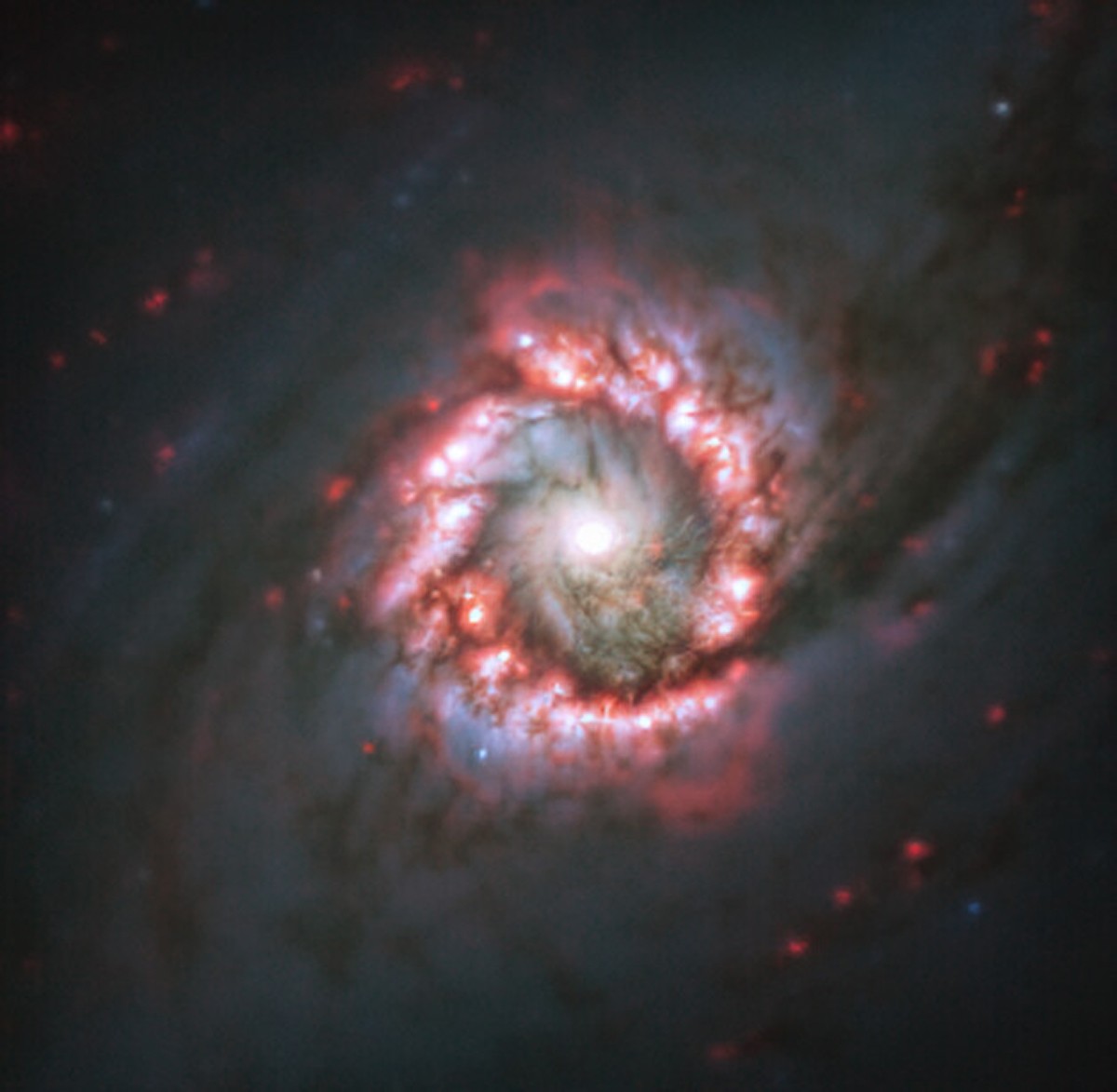How Long To Travel A Light Year? This question sparks curiosity about the vastness of space and our ability to traverse it. TRAVELS.EDU.VN explores the mind-boggling distances involved and the technologies required to even contemplate such a journey. Understanding light years opens up a universe of possibilities for space travel, interstellar voyages, and exploring cosmic distances.
1. Understanding the Light Year: A Cosmic Unit of Measurement
A light year, as the name suggests, is the distance light travels in one Earth year. Given that light travels at an astounding speed of approximately 299,792,458 meters per second (roughly 186,282 miles per second), this distance is immense. To put it in perspective, one light year is equivalent to about 9.46 trillion kilometers (5.88 trillion miles). It’s a unit used to measure the enormous distances between stars and galaxies, making the cosmos more comprehensible. Using kilometers or miles for such distances would be like measuring the distance between cities in millimeters – impractical and unwieldy. According to NASA, a light-year isn’t a measure of time, but rather a measure of distance—a very, very long distance.
1.1. Light Speed and Cosmic Distances
Light speed is the ultimate speed limit in the universe, according to Einstein’s theory of relativity. Nothing can travel faster than light, making it a fundamental constant in physics. This speed is crucial for understanding light years, as it defines the scale of cosmic distances. Measuring distances in light years allows astronomers and space enthusiasts to grasp the sheer size of the universe.
1.2. Astronomical Unit (AU) vs. Light Year
Before delving deeper, it’s important to differentiate between an Astronomical Unit (AU) and a light year. An AU is the average distance between the Earth and the Sun, approximately 150 million kilometers (93 million miles). AUs are primarily used for measuring distances within our solar system, while light years are used for interstellar distances. For example, the diameter of our solar system is about 1,921 AUs, while the distance to the nearest star, Proxima Centauri, is 4.25 light years.
2. Time Travel and Looking Back in Time
One of the most fascinating aspects of light years is that when we observe objects at great distances, we are essentially looking back in time. The light we see from a star 100 light years away has been traveling for 100 years to reach us. Therefore, we are seeing that star as it existed 100 years ago.
2.1. Proxima Centauri: Our Nearest Stellar Neighbor
Proxima Centauri, the closest star to our solar system, is approximately 4.25 light years away. This means that if Proxima Centauri were to suddenly explode, we wouldn’t know about it for 4.25 years. The light from that event would take that long to reach Earth, offering a captivating glimpse into the past.
2.2. Observable Universe
The radius of the observable universe extends approximately 46.6 billion light years in all directions from Earth. This boundary represents the farthest we can see, as light from more distant objects has not had enough time to reach us since the Big Bang. When we observe galaxies near this boundary, we are seeing them as they were billions of years ago, providing invaluable insights into the early universe.
 Distant Galaxy
Distant Galaxy
The immense distances and time scales involved in observing distant galaxies highlight the profound nature of light years. This image shows Galaxy NGC 1097, which is 45 million lightyears from Earth.
3. The Challenge of Interstellar Travel: How Long Would It Take?
Given the immense distances measured in light years, the prospect of traveling even a fraction of a light year is a daunting challenge. Current technology is nowhere near capable of achieving speeds necessary for interstellar travel within a reasonable timeframe.
3.1. Current Spacecraft Speeds
Manned spacecraft, such as the Apollo missions, can reach speeds of around 39,400 kilometers per hour (24,500 miles per hour). At this speed, it would take approximately 27,000 years to travel just one light year. To reach Proxima Centauri, it would take well over 100,000 years.
3.2. Everyday Transportation
To illustrate the scale of the challenge, consider everyday forms of transportation. A commercial airplane traveling at 965 kilometers per hour (600 miles per hour) would take over a million years to travel one light year. A car traveling at an average speed of 90 kilometers per hour (56 miles per hour) would take approximately 12 million years. Even walking at a brisk pace of 5 kilometers per hour (3 miles per hour) would take a staggering 216 million years to cover a single light year.
3.3. Earth’s Orbital Speed
Earth orbits the Sun at approximately 107,000 kilometers per hour (67,000 miles per hour). Even at this considerable speed, it would take Earth about 10,000 years to travel one light year. Our solar system, as a whole, travels through the galaxy at about 720,000 kilometers per hour (448,000 miles per hour), which would still take around 1,500 years to travel a light year.
 Car Lightyear Travel
Car Lightyear Travel
To travel a light year at the speed of a car, it would take millions of years, highlighting the vastness of space.
4. Hypothetical Faster-Than-Light Travel
The immense distances involved in interstellar travel have led scientists and science fiction writers to explore hypothetical methods of faster-than-light (FTL) travel. While these concepts remain largely theoretical, they offer intriguing possibilities for overcoming the limitations imposed by the speed of light.
4.1. Wormholes
Wormholes, also known as Einstein-Rosen bridges, are theoretical tunnels through spacetime that could potentially connect two distant points in the universe. While wormholes are predicted by Einstein’s theory of general relativity, their existence has not been confirmed, and even if they exist, it’s unclear whether they could be traversable.
4.2. Warp Drives
Warp drives are another theoretical concept that involves warping spacetime around a spacecraft, allowing it to travel faster than light relative to distant observers. This concept, popularized by science fiction, would require immense amounts of energy and exotic matter with negative mass-energy density, which has not yet been discovered.
4.3. Laser Propulsion
One of the more plausible approaches to interstellar travel involves using powerful lasers to propel small spacecraft to a significant fraction of the speed of light. The Breakthrough Starshot project, for example, aims to use a massive array of synchronized lasers to push a small, hand-sized spacecraft to 25% of the speed of light. This would allow it to reach Proxima Centauri in approximately 20 years.
4.4. Challenges of FTL Travel
Even with these hypothetical methods, significant challenges remain. The energy requirements for warp drives and wormholes are astronomical, and the physics involved are not fully understood. Laser propulsion, while more feasible, still requires significant technological advancements and investments. The effects of relativistic speeds on spacecraft and astronauts also need to be carefully considered.
5. The Role of TRAVELS.EDU.VN in Future Space Exploration
While interstellar travel remains a distant dream, TRAVELS.EDU.VN is committed to keeping you informed about the latest developments in space exploration. We aim to inspire and educate our audience about the wonders of the universe and the cutting-edge technologies that may one day make interstellar travel a reality. By following our updates, you can stay abreast of the newest discoveries, missions, and theoretical breakthroughs that are shaping the future of space exploration.
5.1. Educational Resources
TRAVELS.EDU.VN provides a wealth of educational resources about space exploration, including articles, videos, and interactive simulations. Our content covers a wide range of topics, from the basics of astronomy to the most advanced concepts in astrophysics. Whether you are a student, a space enthusiast, or simply curious about the universe, you will find something to engage and inform you.
5.2. Community Engagement
We also foster a vibrant community of space enthusiasts through our online forums and social media channels. Here, you can connect with like-minded individuals, share your thoughts and ideas, and participate in discussions about the latest developments in space exploration. We encourage you to join our community and become part of the conversation.
5.3. Supporting Space Research
TRAVELS.EDU.VN also supports space research through partnerships with leading research institutions and organizations. We highlight the work of scientists and engineers who are pushing the boundaries of human knowledge and developing the technologies that will enable us to explore the cosmos. By supporting their efforts, we hope to accelerate the pace of discovery and bring the dream of interstellar travel closer to reality.
6. Why Napa Valley is a Must-Visit Destination
While the vastness of space and the challenges of interstellar travel may seem far removed from our daily lives, there are still incredible destinations to explore right here on Earth. Napa Valley, located in California, is one such place. Known for its stunning vineyards, world-class wineries, and gourmet cuisine, Napa Valley offers a unique and unforgettable travel experience.
6.1. World-Class Wineries
Napa Valley is home to hundreds of wineries, ranging from small, family-owned estates to large, internationally renowned producers. Visitors can enjoy wine tastings, vineyard tours, and learn about the art of winemaking from expert vintners. Some of the most popular wineries include Robert Mondavi Winery, Beringer Vineyards, and Castello di Amorosa. According to the Napa Valley Vintners association, the region boasts over 400 wineries, each offering a unique taste of Napa Valley.
6.2. Gourmet Cuisine
In addition to its exceptional wines, Napa Valley is also a culinary paradise. The region is home to a variety of acclaimed restaurants, offering everything from casual farm-to-table fare to Michelin-starred fine dining experiences. Many restaurants feature locally sourced ingredients and offer wine pairings to complement their dishes. The French Laundry, one of the most famous restaurants in the United States, is located in Yountville, Napa Valley.
6.3. Scenic Beauty
Napa Valley is not only a destination for wine and food lovers but also for those who appreciate natural beauty. The rolling hills covered with vineyards, the picturesque towns, and the stunning sunsets create a breathtaking backdrop for any visit. Visitors can explore the region by car, bike, or even hot air balloon, taking in the beauty of the landscape at their own pace.
7. Planning Your Napa Valley Getaway with TRAVELS.EDU.VN
Planning a trip to Napa Valley can be overwhelming, given the many options for wineries, restaurants, and accommodations. That’s where TRAVELS.EDU.VN comes in. We offer a range of curated travel packages designed to make your Napa Valley experience seamless and unforgettable.
7.1. Custom Travel Packages
At TRAVELS.EDU.VN, we understand that every traveler has unique preferences and interests. That’s why we offer custom travel packages tailored to your specific needs. Whether you’re looking for a romantic getaway, a family vacation, or a group excursion, we can create a personalized itinerary that meets your budget and exceeds your expectations.
7.2. Expert Recommendations
Our team of travel experts has extensive knowledge of Napa Valley and can provide you with insider tips and recommendations. We can help you choose the best wineries to visit, the most delicious restaurants to dine at, and the most comfortable accommodations to stay in. We can also arrange private tours, wine tastings, and other exclusive experiences.
7.3. Stress-Free Planning
Planning a vacation can be time-consuming and stressful. TRAVELS.EDU.VN takes the hassle out of travel planning by handling all the details for you. From booking flights and hotels to arranging transportation and activities, we take care of everything so you can relax and enjoy your trip.
8. Napa Valley Travel Tips
To ensure you have the best possible experience in Napa Valley, here are a few travel tips to keep in mind:
8.1. Best Time to Visit
The best time to visit Napa Valley is typically during the spring (March-May) or fall (September-November). During these months, the weather is mild and pleasant, and the vineyards are at their most beautiful. However, Napa Valley is a year-round destination, and each season offers its own unique charm.
8.2. Transportation
While it’s possible to explore Napa Valley by car, it’s often more convenient to hire a driver or take a guided tour. This allows you to enjoy the wine tastings without worrying about driving. There are also several shuttle services and ride-sharing options available in the region.
8.3. Reservations
Many wineries and restaurants in Napa Valley require reservations, especially during peak season. It’s a good idea to book your tastings and meals in advance to avoid disappointment. You can often make reservations online or by phone.
8.4. Dress Code
The dress code in Napa Valley is generally casual but stylish. Comfortable shoes are a must, as you’ll likely be doing a lot of walking. It’s also a good idea to bring a light jacket or sweater, as the evenings can be cool.
8.5. Pace Yourself
Wine tasting can be a marathon, not a sprint. It’s important to pace yourself and drink responsibly. Be sure to stay hydrated and eat plenty of food to avoid becoming overly intoxicated.
9. Creating Unforgettable Experiences with TRAVELS.EDU.VN
At TRAVELS.EDU.VN, we are dedicated to creating unforgettable travel experiences for our clients. We go above and beyond to ensure that every trip is seamless, enjoyable, and tailored to your unique preferences. Whether you’re dreaming of exploring the vastness of space or indulging in the delights of Napa Valley, we are here to make your travel dreams a reality.
9.1. Client Testimonials
“TRAVELS.EDU.VN planned the perfect Napa Valley getaway for my wife and me. Every detail was taken care of, from the wine tastings to the restaurant reservations. We couldn’t have asked for a better experience.” – John S.
“I was overwhelmed with the options for wineries in Napa Valley, but TRAVELS.EDU.VN helped me choose the best ones based on my interests. The private tour they arranged was fantastic, and I learned so much about winemaking.” – Sarah L.
“TRAVELS.EDU.VN made planning our family vacation to Napa Valley a breeze. They found the perfect accommodations for us and arranged activities that everyone enjoyed. I highly recommend their services.” – Michael B.
9.2. Contact Us Today
Ready to start planning your Napa Valley adventure? Contact TRAVELS.EDU.VN today to speak with one of our travel experts. We can help you create a custom itinerary that meets your needs and exceeds your expectations.
Address: 123 Main St, Napa, CA 94559, United States
WhatsApp: +1 (707) 257-5400
Website: TRAVELS.EDU.VN
10. Frequently Asked Questions (FAQ) About Light Years
10.1. What is a light year?
A light year is the distance light travels in one Earth year, approximately 9.46 trillion kilometers (5.88 trillion miles).
10.2. How fast does light travel?
Light travels at approximately 299,792,458 meters per second (186,282 miles per second) in a vacuum.
10.3. Why do we use light years to measure distance in space?
Light years are used because the distances between stars and galaxies are so vast that using kilometers or miles would be impractical.
10.4. How long would it take to travel one light year with current technology?
With current spacecraft speeds, it would take approximately 27,000 years to travel one light year.
10.5. What is the closest star to our solar system?
The closest star to our solar system is Proxima Centauri, which is approximately 4.25 light years away.
10.6. What is the observable universe?
The observable universe is the region of space that we can see from Earth, which has a radius of approximately 46.6 billion light years.
10.7. What are some hypothetical methods of faster-than-light travel?
Some hypothetical methods include wormholes, warp drives, and laser propulsion.
10.8. Are wormholes real?
Wormholes are theoretical tunnels through spacetime predicted by Einstein’s theory of general relativity, but their existence has not been confirmed.
10.9. How does looking at distant objects in space allow us to look back in time?
When we observe objects at great distances, the light we see has been traveling for a long time to reach us, so we are seeing those objects as they existed in the past.
10.10. How can TRAVELS.EDU.VN help me plan my trip to Napa Valley?
TRAVELS.EDU.VN offers custom travel packages, expert recommendations, and stress-free planning services to make your Napa Valley experience unforgettable.
11. Conclusion: The Universe Awaits, and Napa Valley Beckons
The concept of a light year provides a humbling perspective on the vastness of the universe and the challenges of interstellar travel. While reaching distant stars may remain a future endeavor, there are still incredible destinations to explore closer to home. Napa Valley, with its world-class wineries, gourmet cuisine, and scenic beauty, offers a unique and unforgettable travel experience. Let travels.edu.vn help you plan your next adventure, whether it’s a trip to Napa Valley or a journey of discovery into the cosmos. Our expert team is ready to curate a personalized itinerary that caters to your specific needs and interests, ensuring a seamless, enjoyable, and memorable experience. Contact us today to begin crafting your dream vacation and unlock the wonders of travel.
